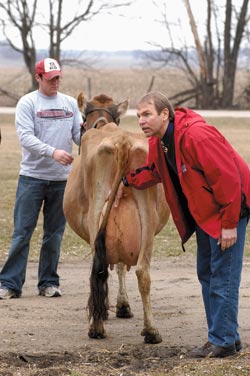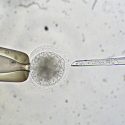Greener pastures: Dairy science reverses history with enrollment surge
It wasn’t long ago that Ted Halbach’s dairy cattle selection course — one of the first classes taken by new dairy science majors — felt a little too select.
“In 2005, I had six students,” says Halbach, who has taught the class since 1999. “You don’t have the diversity of opinion among students that you get with classes of 15 to 30 students. The different perspectives each student brings really enriches the discussion in a class like this one.”

Students in the class Dairy Science 205: Dairy Cattle Selection have a firsthand opportunity to learn about the methodology and art of dairy cattle judging during a class field trip to Gil-Bar Jerseys in Janesville, Wis. Ted Halbach (right), who coordinates student recruiting in the Department of Dairy Science, has worked to increase enrollment in the program by emphasizing the many dairy resources that can be found in Wisconsin.
Photo: Jeff Miller
When Halbach teaches the course this spring, however, it will be a different story. This fall, 29 freshmen enrolled in the Department of Dairy Science, more than triple its entering class from just three years ago.
Since enrolling 189 undergraduate students in 1982, dairy science has seen a steady decline in popularity. By 2004, fewer than 60 students were majoring in the field, and when only eight students signed on that fall, it raised concerns that one of UW–Madison’s oldest and most traditional fields of study was falling off the modern student’s radar.
“One of the ways we serve the dairy industry is by providing employees, and we weren’t filling the pipeline,” says department chair Ric Grummer. “There was a concern that maybe we were letting down our clientele.”
In response, the department launched a major overhaul, retooled its curriculum to be more hands-on and sharpened its focus on dairy management. At the same time, it brought in an independent marketing firm to evaluate its student recruitment activities.
The firm’s main message: If you want more students, take it personally.
“I think the thing that clicked for me was that it’s about what kind of experience a student can have here,” says Halbach, who coordinates the department’s recruiting. “While our rankings are nice, kids don’t make their decisions based on how we’re ranked. They want to know what their lives will be like if they come here.”
When talking to students, Halbach now trumpets UW–Madison’s campus and its location in “the heart of dairy,” as the department’s new materials describe it. “We have so many resources around us — industry, farms, World Dairy Expo — and we’re at the hub of it all,” he says.
When talking to students, Halbach now trumpets UW–Madison’s campus and its location in “the heart of dairy,” as the department’s new materials describe it. “We have so many resources around us — industry, farms, World Dairy Expo — and we’re at the hub of it all,” he says. The department also inaugurated a fall preview day for prospective students and sets up shadow days, during which recruits are paired with current students to get a sense of the campus experience.
Perhaps as important is how Halbach delivers those messages. As a youth extension specialist, he travels regularly to shows and fairs to talk one-on-one with prospective students. At last year’s state convention for the National FFA Organization, for instance, he enticed more than 200 students to fill out information sheets by entering them in a drawing for an iPod.
“Our booth looked like a riot scene,” he says. “I had to recruit my daughter to help hand out forms.”
“Ted has made heroic efforts to seek new students and get them to commit to the UW–Madison dairy science program,” says Robert Ray, associate dean for undergraduate programs at the College of Agricultural and Life Sciences. “Dairy science is reaching potential students who are in some cases in middle school. We know from research that students make a decision to attend college by the time they enter the eighth grade. Having contact at that point in life is not something we have consistently done across departments, but dairy science is doing it.”
The program also has gained some bounce from an improving climate for agriculture. Strong milk and commodity prices are helping farms grow and expand, and students seem to be getting the message. Nationally, student membership in organizations such as FFA is up, eclipsing a half million nationally for the first time since 1978.
“We went through a time when dairy parents were discouraging their kids from going into the dairy industry,” says Grummer. “I think we’ve turned that corner now. The youth are seeing their parents’ businesses grow, expand and become successful, and they look at it as a vibrant industry and excellent career choice.”
But dairy-minded students have options, including dairy programs at the University of Minnesota, UW-River Falls and UW-Platteville, as well as Cornell University, which recruits in the Midwest for its dairy program. Grummer says the department had lagged behind some of those schools in the amount of scholarship money it could offer students. “Our pool hadn’t changed for years, and we were offering these $1,000 and $1,500 scholarships that back in 1978 were a big wad of money,” he says. “We could see very clearly we were falling behind.”
With support from donors and alumni, the department has now increased its available scholarship money from $35,000 in 2004 to nearly $75,000 today.
Grummer also credits a pilot admissions project, enacted during the last application cycle, which allows students applying to production agriculture majors to be admitted in cases where they might otherwise be accepted at a later date. In previous years, he says several of the department’s recruits received postponed admissions decisions, meaning they didn’t find out if they were admitted to UW–Madison until late in their senior years. By that time, most had decided to go elsewhere.
In the end, though, Halbach and Grummer agree that those programs wouldn’t have made much of a difference without the fresher approach to marketing the program to students.
“We had a commitment to recruiting before. What’s really helped our results is the targeting of our resources,” Halbach says. “I always felt like I worked hard at student recruiting before, but I have a lot more effective tools now than in the past.”



